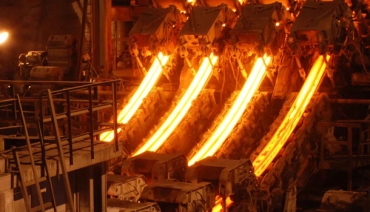The global steel industry produced over 1.6 billion tonnes of crude steel in 2013, and has produced similar levels every year for the past decade. Steel production has undergone a colossal evolution since it was first automated in the late 1850s. Before that, steel was prohibitively expensive and limited to small scale, local manufacturing of armour and weapons.
This article excludes those early years of steelmaking, where knights errant would have their local smith craft them a personalised suit of armour. Here we take a look at the automation of steel production and the mass production of the metal that became a driving force in the UK’s industrial revolution during the mid-19th century.
Until around the 1850s steel was expensive, made in small quantities and was used almost exclusively for weapons, armour and small tools. The Bessemer process, invented by Englishman Henry Bessemer during the 1850s, alongside the open hearth process, which was discovered around a similar time, revolutionised the way steel was produced making it inexpensive and many times more efficient.
The hub of steel manufacture was Sheffield, with steel shipped from the city across Europe and the Americas. The demand for the product was magnified by the expansion of the railways and the demand for stronger rails to support faster and heavier freight.
For years Britain was the centre of global steel production, accounting for around 40% of all global production. Roughly 40% of Britain’s output was exported to the USA to supply the demand generated by their expanding railways and industry. The success was relatively short lived however, as by the turn of the century output had fallen to little over 20%. The USA was producing its own steel and Germany was beginning to take hold of the European market.
The Bessemer process was succeeded by open-heart steelmaking in the final years of the 19th century and by the early to mid-part of the 20th century it had been completely replaced. Open heartsteelmaking emanated from Germany in the 1860s and became known as the Siemen’s-Martin process after its early pioneers. The process allowed greater control over the steel’s composition as well as increasing the amount of scrap that could be included in the charge.
Steelmaking was revolutionised again by falling electricity costs in the early 20th century as the electric arc furnace replaced the crucible process of steel manufacture.
Following the Second World War, a lack of innovation in the UK and a failure of the British government to persuade plants to upgrade further led to the decline in British steel. The Iron and Steel Act of 1949 nationalised the country’s steel production, an act reinforced by aid from the Marshall Plan in the late 1940s.
The 1950s saw the privatisation of steel by the Conservative governments, and was re-nationalised once more in the late 1960s. This yo-yoing and political meddling meant companies such as British Steel struggled with outdated technology and low efficiencies and the entire industry fell into serious decline.
Margaret Thatcher’s government in the 1980s re-privatised British Steel and since the entire industry has worked tirelessly to become competitive on a global scale once more. The 1990s saw a gentle improvement in demand for British steel and the industry has gone from strength to strength since that day.
Today, UK demand for steel mill products hovers around 10 million tonnes per year. Whilst this is some 33% lower than its peak in the 1970s, the industry is healthy and reflects global trends. Some 20,000 people are employed in the steel production industry and the UK produced almost 12 million tonnes of crude steel in 2013 alone.
The industry is not solely limited to steel production, and the wider industry employs several thousand more people. Companies such as wesellrsj.co.uk for example, sell on manufactured I-beams and other structural steel beams.
In its entirety, the industry turned over an estimated £7 billion in 2014 and is growing steadily, helped by a resurgent construction industry. Despite the industry being mature, it is predicted to grow at an annual rate of 2% over the next five years in line with the steadily recovering British economy.

